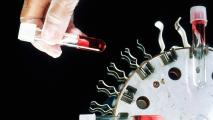The first baby to receive a groundbreaking spina bifida treatment delivered in the womb is now one year old — and, so far, shows no signs of the leg paralysis doctors expected her to be born with.
The challenge: Spina bifida is a birth defect in which the spine doesn’t form correctly. In its most severe form, called myelomeningocele, a part of the spinal cord is exposed through an opening in the back — this can cause major cognitive and mobility issues, including paralysis.
Spina bifida can be diagnosed through ultrasound, and in some cases, surgeons can close the back opening while a baby is still in the womb. This can prevent further damage to their spinal cord, but it can’t reverse existing damage.
Without any treatment, the baby was expected to be born with leg paralysis.
The surgery: In July 2021, a woman named Emily and her 25-week-old fetus underwent a spina bifida repair operation at UC Davis Health, but before surgeons closed the fetus’ back opening, they placed a patch laced with stem cells directly on her exposed spinal cord.
This first-of-its-kind spina bifida treatment, combining surgery and stem cells, had delivered remarkable results in animals, and Emily’s baby was the first person to undergo the procedure as part of the CuRe Trial (Cellular Therapy for In Utero Repair of Myelomeningocele).
Ten weeks after surgery, Emily gave birth to her daughter Robbie, and she was thrilled to see the newborn wiggling her toes — without any treatment, the baby was expected to be born with leg paralysis.
Looking ahead: Robbie is now one year old and in good health. Two other babies have already since been born after undergoing the new spina bifida treatment, and the CuRe Trial is expected to treat 35 in total.
It’s still too soon to say whether the combination of stem cells and surgery will improve outcomes for patients, but the hope is that the stem cells will repair some of the spinal tissue that was damaged before the operation, leading to fuller recovery.
The researchers plan to follow up with the children until they are six years old, but their status at 2.5 years, when toddlers are typically walking and potty training, should be a good indicator of the treatment’s success.
“This experience has been larger than life and has exceeded every expectation,” said Emily. “I hope this trial will enhance the quality of life for so many patients to come. We are honored to be part of history in the making.”
We’d love to hear from you! If you have a comment about this article or if you have a tip for a future Freethink story, please email us at tips@freethink.com.






